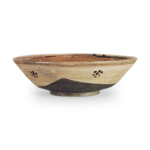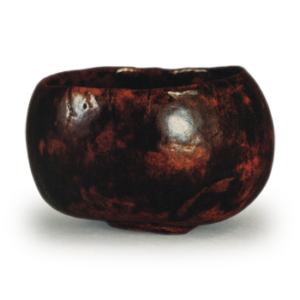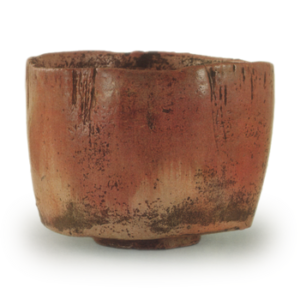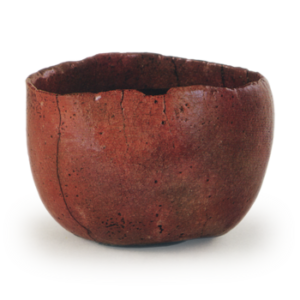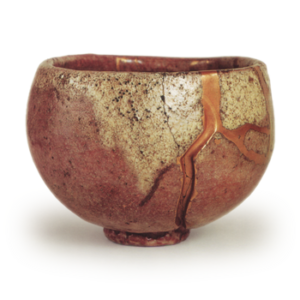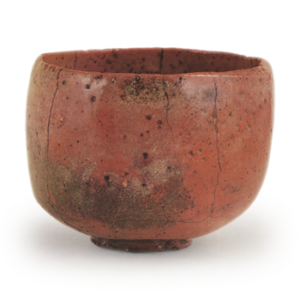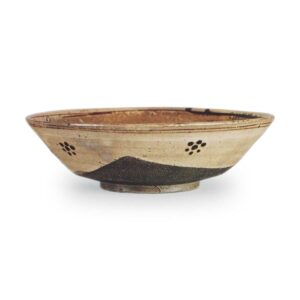
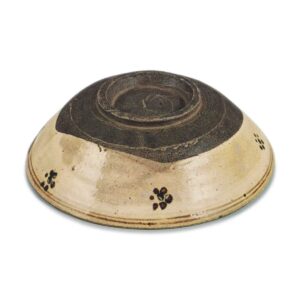
Nezu Museum
Height: 4.7cm
Diameter: 16.0cm
Height of foot ring: 6.5cm
Height of rim: 0.6cm
The term “E-Koryo” in the tea ceremony refers to the painted porcelain of the Cizhou kilns, and is thought to have been produced during the Ming dynasty. The name is thought to have come about because the ancients believed it to be from Korea. The name ‘E-Koryo’ also appears in the book ‘Kokin Wakan Shodogu Kenchisa’ (A Guide to Ancient and Modern Japanese and Chinese Tools), which was compiled in 1694, but this article is a reprint from the ‘Kan’ei Tekagami’ (Kan’ei Reference Book), so it is clear that this name was already in use from around the Kan’ei era. However, the article itself is only a few lines long, saying things like “It is called E-Koryo because of the colored patterns on it” or “It is the same as the Mishima-te”.
The only detailed description of E-Koma we have is in the ‘Koma Chawan Shidai Roku’ (Record of Koma Tea Bowls), which dates from the end of the Edo period. It still assumes that they are a type of Koma tea bowl, and says
The rim is flat and the body is double-walled, and the clay is white and very thin, so you can see the clay. The outside is cut in a circle, and it is a very striking piece. The way the inside is taken is deeper than the outside, and it is high and deep.
There are lines on the edge of the picture, and the soil looks like a snake’s eye in a tea pool. The outside is white with indigo medicine up to the waist, and it is called a plum bowl (plum bowl illustration). The inside is decorated with lines, and the outside rim also has lines, and there are also designs that look like tree leaves or Chinese flowers and scrolls. This is the next type of umebachi. This type includes bowls, sake jugs, and other vessels, as well as figurines, and there are also firelight cups. There are also incense containers, but they are of a different style.
The part where the tatami mat is attached has a coating of clay. The first thing to note is the white design on the indigo-colored glaze.
The description is very detailed, and it is easy to see the actual item.
It is a flat bowl with a fine grayish-white clay body, and there is a single-stroke pattern around the foot ring, and a snail pattern in the middle. The pattern of the plum blossom bowl is the most highly prized, and even among plum blossom bowls, those painted with white clay on top of a brush of underglaze iron clay are rarer than those painted with white clay on a white background, so they are highly prized.
The style of painting on the surface of the bowl, known as “E-Koma-Ume-bachi-te”, originated in the Kamigata region and became popular when it was used for summer festival kama. It is similar to the Seto Karatsu Kawa-gei-te and Totoya Hira-chawan styles, but the Ume-bachi-te style in particular became the focus of interest for tea ceremony enthusiasts because of its rarity.
This painting of a Korean plum bowl, which was a favorite of Aoyama-o, is considered to be a representative work of the cast-glaze plum bowl style. The inside and outside of the bowl are covered in white slip, and the soft, pale cream-colored underglaze is decorated with plum blossoms, giving the bowl a tea-like atmosphere. The foot ring is decorated with a two-tiered hatake-gata pattern, and the tea-dama (tea-drip) area is decorated with a “snake’s eye” pattern.
Aoyama-o also had a bowl with a white Japanese apricot design on a light blue background, which he treasured as a pair with this bowl, and this further enhanced his reputation as a connoisseur.

